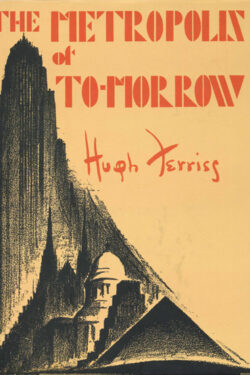Lavish historical scenery often appeared in Ferriss’s fantasy drawings of the early twenties. In 1922, the year of the famed competition for the Chicago Tribune tower, the skyscraper was still pre-modern, at least in terms of style. Although he preached the prospect of a new architecture born of the zoning law in his 1922 New York Times article, Ferriss had no stance on what these new towers should look like, so, like most of the architects of the period, he summoned historical precedents.
Ferriss was less attracted to famous monuments like the Parthenon or Chartres than to vast architectural tableaux of the ancient civilizations of the Near East, Indochina, or Imperial Rome. A fascination with Babylon and other fallen civilizations was a popular theme among artists and writers in the early twentieth century, and the Tower of Babel was a common trope for setback skyscrapers, which were often referred to as modern ziggurats in the “New Babylon of New York.”
In these pen-and-ink drawings of 1922 and 1924, which are much closer to his earlier graphic style than to the dark charcoal renderings of the later twenties, Ferriss evokes a new cityscape of setback towers topped by expansive terraces, roof gardens, and a new urban elite who live in the sky.
Carol Willis
Carol is the founder, director, and curator of The Skyscraper Museum, located in Battery Park City. An architectural and urban historian, Carol is the author of the book Form Follows Finance: Skyscrapers and Skylines in New York and Chicago, which was recognized by AIA and given the Kenneth Jackson Award For Best Book In North American Urban History by the Urban History Association. In her twenty years leading The Skyscraper Museum, she has curated more than twenty exhibitions on high-rise history and urbanism. Carol’s numerous publications include essays on the history of New York City’s zoning law. She made frequent appearances on The History Channel, PBS, NPR, and BBC. Since 1989, she has taught in the GSAPP program The Shape of Two Cities/ New York and Paris as an Adjunct Associate Professor of Urban Studies at Columbia University.
